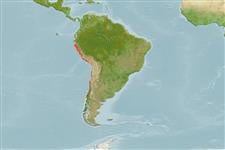Common names from other countries
Environment: milieu / climate zone / depth range / distribution range
экология
; пределы глубины 0 - 500 m (Ref. 356). Tropical, preferred 20°C (Ref. 107945); 5°S - 42°S, 81°W - 70°W (Ref. 106891)
Southeast Pacific: From Paita, Peru to Chiloé, Chile. Tropical to subtropical.
Length at first maturity / Size / Вес / Возраст
Maturity: Lm ? range ? - ? cm Max length : 12.0 cm ShL самец/пол неопределен; (Ref. 356)
Found in shallow bays (Ref. 106891). Inhabits sedimentary grounds in sheltered areas at depths from 5 to 40 m (Ref. 106862).
Life cycle and mating behavior
половая зрелость | размножение | нерест | икра | Fecundity | личинки
Life cycle: Embryos develop into free-swimming trocophore larvae, succeeded by the bivalve veliger, resembling a miniature clam (Ref. 833). Spawning occurs year-round but mainly during spring and autumn (Ref. 106788).
Основная ссылка
ссылки | координатор | соавторы
SAUP Database. 2006. (Ref. 356)
Статус Красного Списка МСОП (Ref. 130435)
Статус СИТЕС (Ref. 108899)
Not Evaluated
Not Evaluated
Использование человеком
рыболовство: коммерческий; аквакультура (рыбоводство): коммерческий
FAO - аквакультура (рыбоводство): production; рыболовство: landings | FishSource | Sea Around Us
инструменты
дополнительная информация
ресурсы в Интернет
Estimates based on models
устойчивость к внешним воздействиям
высокий, минимальное время удвоения популяции до 15 месяцев (K=1.99-2.88).
Уязвимость
Low vulnerability (10 of 100).
